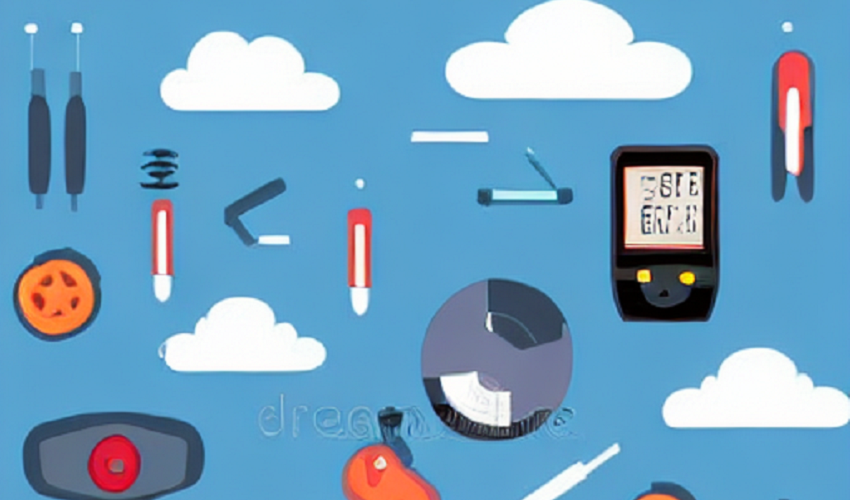Overview
Introduction to diabetes management
Diabetes management is a crucial aspect of maintaining a healthy lifestyle for individuals living with this chronic condition. With the advancements in technology, there have been significant improvements in the tools and resources available for managing diabetes. In this article, we will explore the various ways technology has been incorporated into diabetes management, including the use of mobile applications, wearable devices, and continuous glucose monitoring systems. By embracing these technological advancements, individuals with diabetes can have better control over their blood sugar levels and improve their overall quality of life.
Importance of incorporating technology
In today’s digital age, incorporating technology into diabetes management has become increasingly important. Technology offers numerous benefits and advancements that can greatly improve the lives of individuals living with diabetes. By using devices such as continuous glucose monitors, insulin pumps, and mobile applications, individuals can easily track their blood sugar levels, administer insulin, and monitor their overall health. These technological advancements not only provide convenience and accuracy, but also empower individuals to take control of their diabetes management. With the ability to receive real-time data and personalized insights, individuals can make informed decisions about their diet, exercise, and medication regimen. Furthermore, technology enables better communication and collaboration between healthcare providers and patients, leading to more effective and personalized care. Overall, the importance of incorporating technology into diabetes management cannot be overstated, as it has the potential to revolutionize the way individuals manage their condition and improve their quality of life.
Benefits of using technology in diabetes management
There are numerous benefits of incorporating technology into diabetes management. Firstly, technology allows for more accurate and convenient monitoring of blood glucose levels. With the use of continuous glucose monitors and smartphone apps, individuals with diabetes can easily track their blood sugar levels throughout the day, providing them with real-time data to make informed decisions about their treatment. Additionally, technology enables better communication and collaboration between patients and healthcare providers. Through telemedicine and online platforms, individuals can easily consult with their doctors, receive guidance, and access educational resources from the comfort of their own homes. This not only improves accessibility to care but also empowers individuals to take an active role in managing their condition. Furthermore, technology offers personalized insights and feedback. By analyzing data collected from wearable devices and smart insulin pens, individuals can gain valuable insights into their lifestyle choices, medication adherence, and overall health. This feedback can help them make necessary adjustments to their diabetes management plan and improve their overall well-being. In conclusion, incorporating technology into diabetes management has the potential to revolutionize the way individuals with diabetes monitor and manage their condition, leading to improved outcomes and a better quality of life.
Monitoring Blood Glucose Levels
Traditional methods of monitoring
Traditional methods of monitoring diabetes involve regular blood sugar testing using a glucose meter. This method requires pricking the finger to obtain a small blood sample, which is then placed on a test strip and inserted into the meter. The meter measures the glucose level in the blood and provides a result within seconds. While this method has been effective in managing diabetes for many years, it can be inconvenient and sometimes painful. Additionally, it only provides a snapshot of the blood sugar level at the time of testing, making it difficult to track fluctuations throughout the day. As technology continues to advance, new methods of monitoring diabetes have emerged, offering more convenience and accuracy in managing the condition.
Continuous glucose monitoring systems
Continuous glucose monitoring systems have revolutionized diabetes management by providing real-time and continuous monitoring of blood glucose levels. These systems use a small sensor inserted under the skin to measure glucose levels in the interstitial fluid. The sensor transmits the data wirelessly to a receiver or a smartphone, allowing individuals with diabetes to track their glucose levels throughout the day. This technology has greatly improved the accuracy and convenience of glucose monitoring, reducing the need for frequent fingerstick tests and providing valuable insights into glucose patterns and trends. By incorporating continuous glucose monitoring systems and tools like the Diabetes Risk Calculator into diabetes management, individuals can make more informed decisions about their diet, exercise, and medication, leading to better control of their blood sugar levels and overall improved health outcomes.
Advantages of continuous glucose monitoring
Continuous glucose monitoring (CGM) offers several advantages for individuals with diabetes. One of the main benefits is the ability to track glucose levels in real-time, providing immediate feedback on how food, exercise, and medication affect blood sugar. This allows for better management and adjustment of insulin doses, leading to improved glycemic control. CGM also helps identify patterns and trends in glucose levels, which can be used to make informed decisions about lifestyle changes and treatment plans. Additionally, CGM reduces the need for fingerstick blood glucose testing, providing a more convenient and less invasive method of monitoring glucose levels. Overall, incorporating CGM technology into diabetes management offers numerous advantages and can greatly enhance the quality of life for individuals with diabetes.
Insulin Delivery Systems
Types of insulin delivery systems
There are several types of insulin delivery systems available for managing diabetes. The most common type is the insulin pen, which is a convenient and portable device that allows for easy and accurate insulin administration. Another option is the insulin pump, which delivers insulin continuously through a small tube inserted under the skin. This method provides more flexibility in insulin dosing and can help maintain stable blood sugar levels throughout the day. Additionally, there are insulin syringes and vials, which require manual measurement and injection of insulin. These traditional methods may be less convenient but are still widely used. It is important for individuals with diabetes to work with their healthcare provider to determine the best insulin delivery system for their specific needs and lifestyle.
Insulin pumps
Insulin pumps are an essential tool for managing diabetes. These devices deliver insulin directly into the body, eliminating the need for multiple daily injections. By continuously monitoring blood sugar levels and providing precise insulin doses, insulin pumps help individuals maintain stable glucose levels throughout the day. This technology not only improves convenience and flexibility but also enhances overall diabetes management. With the ability to adjust insulin delivery based on individual needs, insulin pumps offer personalized and tailored treatment options for people with diabetes. As technology continues to advance, insulin pumps are becoming increasingly sophisticated, offering features such as continuous glucose monitoring and smart algorithms that can predict and prevent hypoglycemic and hyperglycemic episodes. Incorporating insulin pumps into diabetes management not only simplifies the daily routine but also empowers individuals to take control of their health and live a more fulfilling life.
Smart insulin pens
Smart insulin pens are innovative devices that have revolutionized diabetes management. These pens are equipped with advanced technology that allows for accurate and precise insulin delivery. With features such as built-in memory, dose tracking, and automatic data syncing to mobile apps, smart insulin pens provide convenience and ease of use for individuals with diabetes. Additionally, these pens can provide real-time feedback and reminders, helping users stay on track with their insulin regimen. Overall, smart insulin pens have significantly improved the management of diabetes by integrating technology into the daily routine of insulin administration.
Diet and Nutrition Tracking
Importance of diet and nutrition in diabetes management
Proper diet and nutrition play a crucial role in managing diabetes effectively. It is essential for individuals with diabetes to have a well-balanced diet that includes a variety of nutrient-rich foods. Tools like a Weight Loss Calculator can help individuals monitor their weight and set realistic goals to improve overall health and diabetes management. This helps in controlling blood sugar levels, maintaining a healthy weight, and preventing complications associated with diabetes. A diet rich in fruits, vegetables, whole grains, lean proteins, and healthy fats can provide the necessary nutrients and help regulate blood sugar levels. Additionally, monitoring carbohydrate intake and portion sizes is important for managing diabetes. By making informed food choices and following a personalized meal plan, individuals can improve their overall health and well-being while effectively managing their diabetes.
Mobile apps for tracking food intake
Mobile apps have become increasingly popular tools for tracking food intake among individuals with diabetes. These apps provide a convenient and accessible way for users to monitor their daily food consumption, track their carbohydrate intake, and calculate insulin doses. They often include features such as barcode scanners, meal planning tools, and personalized recommendations based on individual dietary goals. By using mobile apps, individuals with diabetes can gain better control over their diet and make informed decisions about their food choices, ultimately leading to improved diabetes management and overall health outcomes.
Benefits of using nutrition tracking apps
Nutrition tracking apps have revolutionized diabetes management by providing numerous benefits. One of the key advantages is the ability to easily track and monitor food intake, allowing individuals to make informed decisions about their diet. These apps provide a comprehensive database of nutritional information, making it easier for users to understand the nutritional content of the foods they consume. Additionally, nutrition tracking apps often offer features such as meal planning and recipe suggestions, helping users create balanced and diabetes-friendly meals. By using these apps, individuals can better manage their blood sugar levels, improve their overall health, and achieve their diabetes management goals.
Exercise and Activity Monitoring
Role of exercise in diabetes management
Exercise plays a crucial role in the management of diabetes. Regular physical activity not only helps in maintaining a healthy weight but also improves insulin sensitivity, which is essential for proper blood sugar control. Exercise can also reduce the risk of cardiovascular complications associated with diabetes and improve overall cardiovascular health. Additionally, physical activity can help lower blood pressure, improve cholesterol levels, and enhance mood and mental well-being. It is recommended that individuals with diabetes engage in at least 150 minutes of moderate-intensity aerobic activity per week, along with muscle-strengthening activities on two or more days. However, it is important to consult with a healthcare professional before starting any exercise regimen to ensure safety and to tailor the exercise plan according to individual needs and abilities.
Wearable fitness trackers
Wearable fitness trackers have revolutionized the way we monitor and manage our health, and this is especially true for individuals with diabetes. These compact devices, worn on the wrist or attached to clothing, are equipped with sensors that track various health metrics such as heart rate, activity levels, and sleep patterns. For people with diabetes, wearable fitness trackers provide valuable insights into their daily physical activity and help them make informed decisions about their diet, exercise, and medication. By seamlessly integrating technology into diabetes management, these trackers have made it easier than ever for individuals to take control of their health and achieve their wellness goals.
Integration of activity data with diabetes management apps
The integration of activity data with diabetes management apps has revolutionized the way individuals with diabetes monitor and manage their condition. With the advancement of technology, individuals can now easily track their physical activity levels and sync this data with their diabetes management apps. This integration allows for a more comprehensive understanding of how physical activity affects blood glucose levels and overall diabetes management. By incorporating activity data into diabetes management apps, individuals can make more informed decisions about their diet, medication, and exercise routines, leading to improved diabetes control and overall health outcomes.
Telemedicine and Remote Monitoring
Benefits of telemedicine in diabetes management
Telemedicine offers several benefits in diabetes management. Firstly, it allows patients to remotely monitor their blood glucose levels, eliminating the need for frequent visits to the doctor’s office. This convenience not only saves time and money but also reduces the risk of exposure to contagious diseases. Additionally, telemedicine enables healthcare providers to access real-time data and provide timely interventions, resulting in better disease management. Moreover, telemedicine facilitates regular communication between patients and healthcare professionals, promoting continuous support and education. Overall, the integration of telemedicine in diabetes management improves patient outcomes, enhances access to care, and empowers individuals to take control of their health.
Remote glucose monitoring
Remote glucose monitoring is a revolutionary technology that has transformed the way diabetes is managed. With this technology, individuals with diabetes can easily monitor their blood glucose levels from the comfort of their own homes, without the need for frequent visits to the doctor’s office. This not only provides convenience for patients but also allows healthcare professionals to remotely monitor their patients’ glucose levels and provide timely interventions if necessary. Remote glucose monitoring has proven to be an effective tool in improving diabetes management and has the potential to significantly improve the quality of life for individuals with diabetes.
Virtual doctor visits
Virtual doctor visits have become increasingly popular in recent years as a convenient and efficient way to receive medical care. With the advancement of technology, individuals with diabetes can now consult with healthcare professionals from the comfort of their own homes. These virtual visits not only save time and money but also offer a range of benefits for diabetes management. One of the key advantages is the ability to reduce blood sugar levels through personalized treatment plans and remote monitoring. By leveraging technology, healthcare providers can closely monitor patients’ glucose levels, provide timely feedback, and make necessary adjustments to their medication or lifestyle. This proactive approach allows for better control of blood sugar and can ultimately lead to improved overall health and well-being.
Conclusion
Summary of the benefits of incorporating technology
Incorporating technology into diabetes management offers numerous benefits. Firstly, it allows for more accurate and efficient monitoring of blood glucose levels. With the use of continuous glucose monitors and smart insulin pens, individuals with diabetes can easily track their glucose levels throughout the day, leading to better management of their condition. Additionally, technology enables remote monitoring and communication with healthcare providers, allowing for timely adjustments to treatment plans and reducing the need for frequent in-person visits.
Moreover, the integration of technology in diabetes management promotes self-management and empowers individuals to take control of their health. Through the use of smartphone apps and wearable devices, patients can monitor their diet, exercise, and medication adherence, leading to improved overall health outcomes. Overall, incorporating technology into diabetes management has the potential to revolutionize the way individuals with diabetes manage their condition, leading to better health outcomes and improved quality of life.
Future advancements in diabetes management technology
Future advancements in diabetes management technology hold great promise for improving the lives of individuals with diabetes. With the rapid advancement of technology, we can expect to see innovative solutions that make diabetes management more convenient, accurate, and personalized. For instance, wearable devices that continuously monitor glucose levels and provide real-time feedback will allow individuals to better manage their blood sugar levels. Additionally, artificial intelligence algorithms can analyze large amounts of data to provide personalized recommendations for diet, exercise, and medication. Furthermore, telemedicine platforms will enable individuals to remotely connect with healthcare professionals, ensuring timely and efficient diabetes management. As technology continues to evolve, we can look forward to a future where diabetes management becomes seamless and accessible for all.
Importance of personalized care in diabetes management
Personalized care is of utmost importance in the management of diabetes. Every individual with diabetes is unique and has different needs and challenges. By providing personalized care, healthcare professionals can tailor treatment plans and interventions to meet the specific needs of each patient. This approach takes into account factors such as lifestyle, preferences, and co-existing medical conditions, ensuring that the management of diabetes is effective and sustainable. Personalized care also involves empowering patients with the knowledge and skills to actively participate in their own care, promoting self-management and better outcomes.
Incorporating technology into diabetes management plays a crucial role in delivering personalized care, as it allows for real-time monitoring, data analysis, and remote communication between patients and healthcare providers. With the help of technology, healthcare professionals can track blood sugar levels, medication adherence, dietary patterns, and physical activity, enabling them to make informed decisions and provide timely interventions. Overall, personalized care, supported by technology, is essential in improving the quality of life for individuals with diabetes and optimizing their long-term health outcomes.




